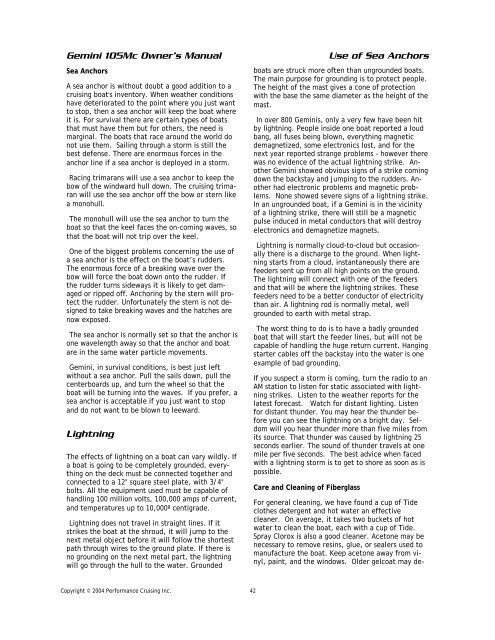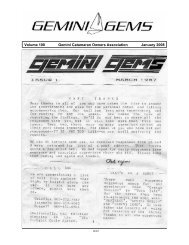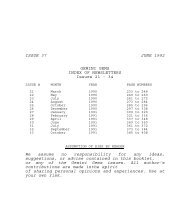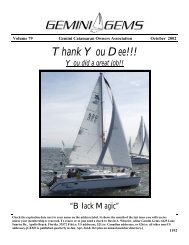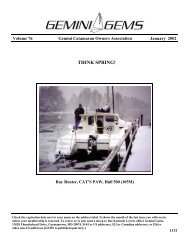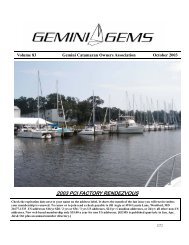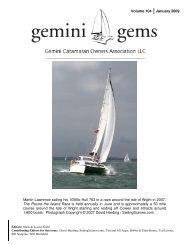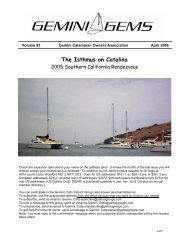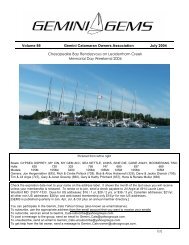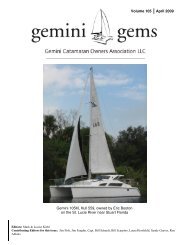Gemini Owners Manual.pub - Gemini Gems
Gemini Owners Manual.pub - Gemini Gems
Gemini Owners Manual.pub - Gemini Gems
You also want an ePaper? Increase the reach of your titles
YUMPU automatically turns print PDFs into web optimized ePapers that Google loves.
<strong>Gemini</strong> 105Mc Owner’s <strong>Manual</strong><br />
Sea Anchors<br />
A sea anchor is without doubt a good addition to a<br />
cruising boat's inventory. When weather conditions<br />
have deteriorated to the point where you just want<br />
to stop, then a sea anchor will keep the boat where<br />
it is. For survival there are certain types of boats<br />
that must have them but for others, the need is<br />
marginal. The boats that race around the world do<br />
not use them. Sailing through a storm is still the<br />
best defense. There are enormous forces in the<br />
anchor line if a sea anchor is deployed in a storm.<br />
Racing trimarans will use a sea anchor to keep the<br />
bow of the windward hull down. The cruising trimaran<br />
will use the sea anchor off the bow or stern like<br />
a monohull.<br />
The monohull will use the sea anchor to turn the<br />
boat so that the keel faces the on-coming waves, so<br />
that the boat will not trip over the keel.<br />
One of the biggest problems concerning the use of<br />
a sea anchor is the effect on the boat’s rudders.<br />
The enormous force of a breaking wave over the<br />
bow will force the boat down onto the rudder. If<br />
the rudder turns sideways it is likely to get damaged<br />
or ripped off. Anchoring by the stern will protect<br />
the rudder. Unfortunately the stern is not designed<br />
to take breaking waves and the hatches are<br />
now exposed.<br />
The sea anchor is normally set so that the anchor is<br />
one wavelength away so that the anchor and boat<br />
are in the same water particle movements.<br />
<strong>Gemini</strong>, in survival conditions, is best just left<br />
without a sea anchor. Pull the sails down, pull the<br />
centerboards up, and turn the wheel so that the<br />
boat will be turning into the waves. If you prefer, a<br />
sea anchor is acceptable if you just want to stop<br />
and do not want to be blown to leeward.<br />
Lightning<br />
The effects of lightning on a boat can vary wildly. If<br />
a boat is going to be completely grounded, everything<br />
on the deck must be connected together and<br />
connected to a 12" square steel plate, with 3/4"<br />
bolts. All the equipment used must be capable of<br />
handling 100 million volts, 100,000 amps of current,<br />
and temperatures up to 10,000º centigrade.<br />
Lightning does not travel in straight lines. If it<br />
strikes the boat at the shroud, it will jump to the<br />
next metal object before it will follow the shortest<br />
path through wires to the ground plate. If there is<br />
no grounding on the next metal part, the lightning<br />
will go through the hull to the water. Grounded<br />
Use of Sea Anchors<br />
boats are struck more often than ungrounded boats.<br />
The main purpose for grounding is to protect people.<br />
The height of the mast gives a cone of protection<br />
with the base the same diameter as the height of the<br />
mast.<br />
In over 800 <strong>Gemini</strong>s, only a very few have been hit<br />
by lightning. People inside one boat reported a loud<br />
bang, all fuses being blown, everything magnetic<br />
demagnetized, some electronics lost, and for the<br />
next year reported strange problems – however there<br />
was no evidence of the actual lightning strike. Another<br />
<strong>Gemini</strong> showed obvious signs of a strike coming<br />
down the backstay and jumping to the rudders. Another<br />
had electronic problems and magnetic problems.<br />
None showed severe signs of a lightning strike.<br />
In an ungrounded boat, if a <strong>Gemini</strong> is in the vicinity<br />
of a lightning strike, there will still be a magnetic<br />
pulse induced in metal conductors that will destroy<br />
electronics and demagnetize magnets.<br />
Lightning is normally cloud-to-cloud but occasionally<br />
there is a discharge to the ground. When lightning<br />
starts from a cloud, instantaneously there are<br />
feeders sent up from all high points on the ground.<br />
The lightning will connect with one of the feeders<br />
and that will be where the lightning strikes. These<br />
feeders need to be a better conductor of electricity<br />
than air. A lightning rod is normally metal, well<br />
grounded to earth with metal strap.<br />
The worst thing to do is to have a badly grounded<br />
boat that will start the feeder lines, but will not be<br />
capable of handling the huge return current. Hanging<br />
starter cables off the backstay into the water is one<br />
example of bad grounding.<br />
If you suspect a storm is coming, turn the radio to an<br />
AM station to listen for static associated with lightning<br />
strikes. Listen to the weather reports for the<br />
latest forecast. Watch for distant lighting. Listen<br />
for distant thunder. You may hear the thunder before<br />
you can see the lightning on a bright day. Seldom<br />
will you hear thunder more than five miles from<br />
its source. That thunder was caused by lightning 25<br />
seconds earlier. The sound of thunder travels at one<br />
mile per five seconds. The best advice when faced<br />
with a lightning storm is to get to shore as soon as is<br />
possible.<br />
Care and Cleaning of Fiberglass<br />
For general cleaning, we have found a cup of Tide<br />
clothes detergent and hot water an effective<br />
cleaner. On average, it takes two buckets of hot<br />
water to clean the boat, each with a cup of Tide.<br />
Spray Clorox is also a good cleaner. Acetone may be<br />
necessary to remove resins, glue, or sealers used to<br />
manufacture the boat. Keep acetone away from vinyl,<br />
paint, and the windows. Older gelcoat may de-<br />
Copyright © 2004 Performance Cruising Inc.<br />
42


